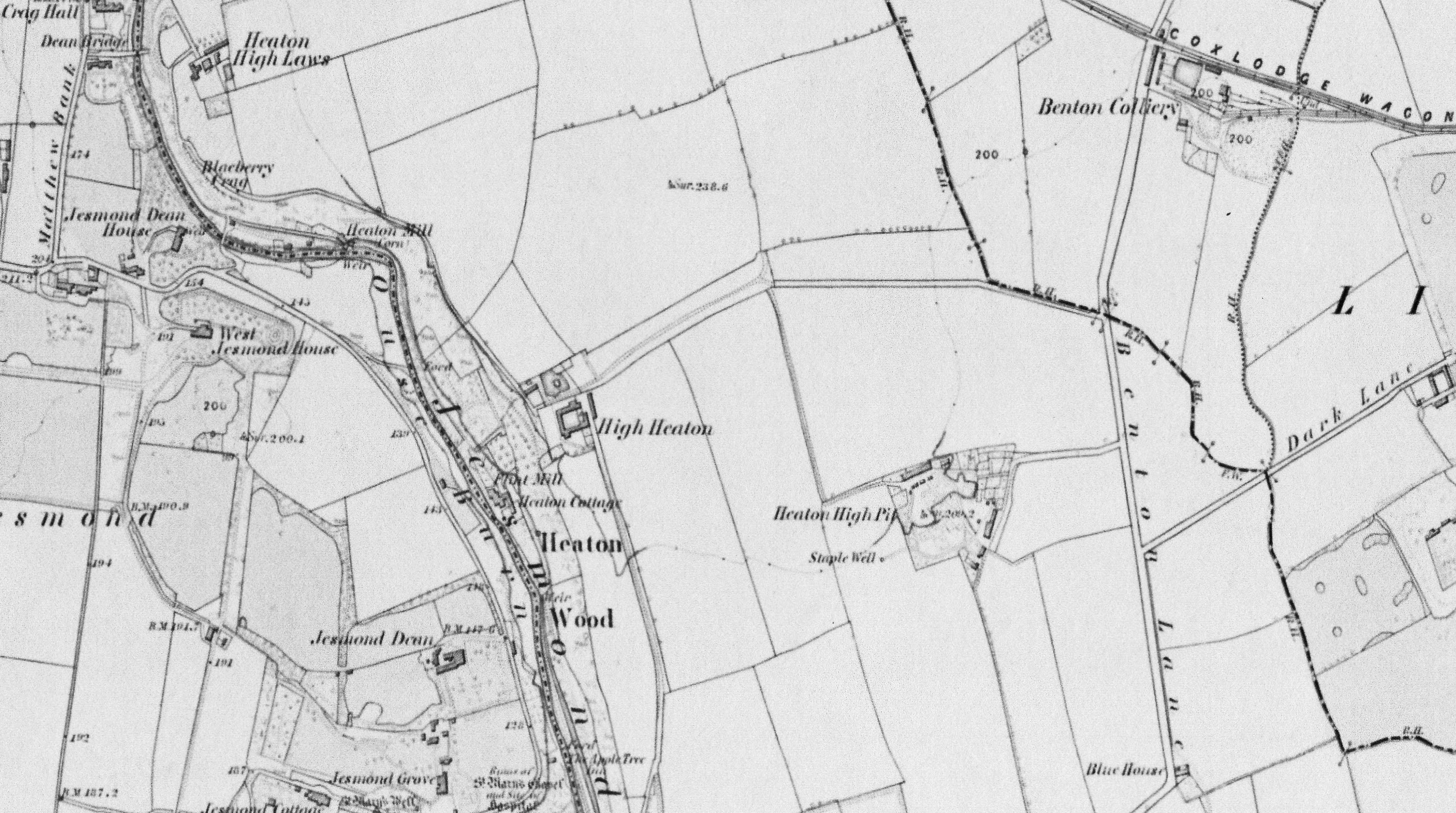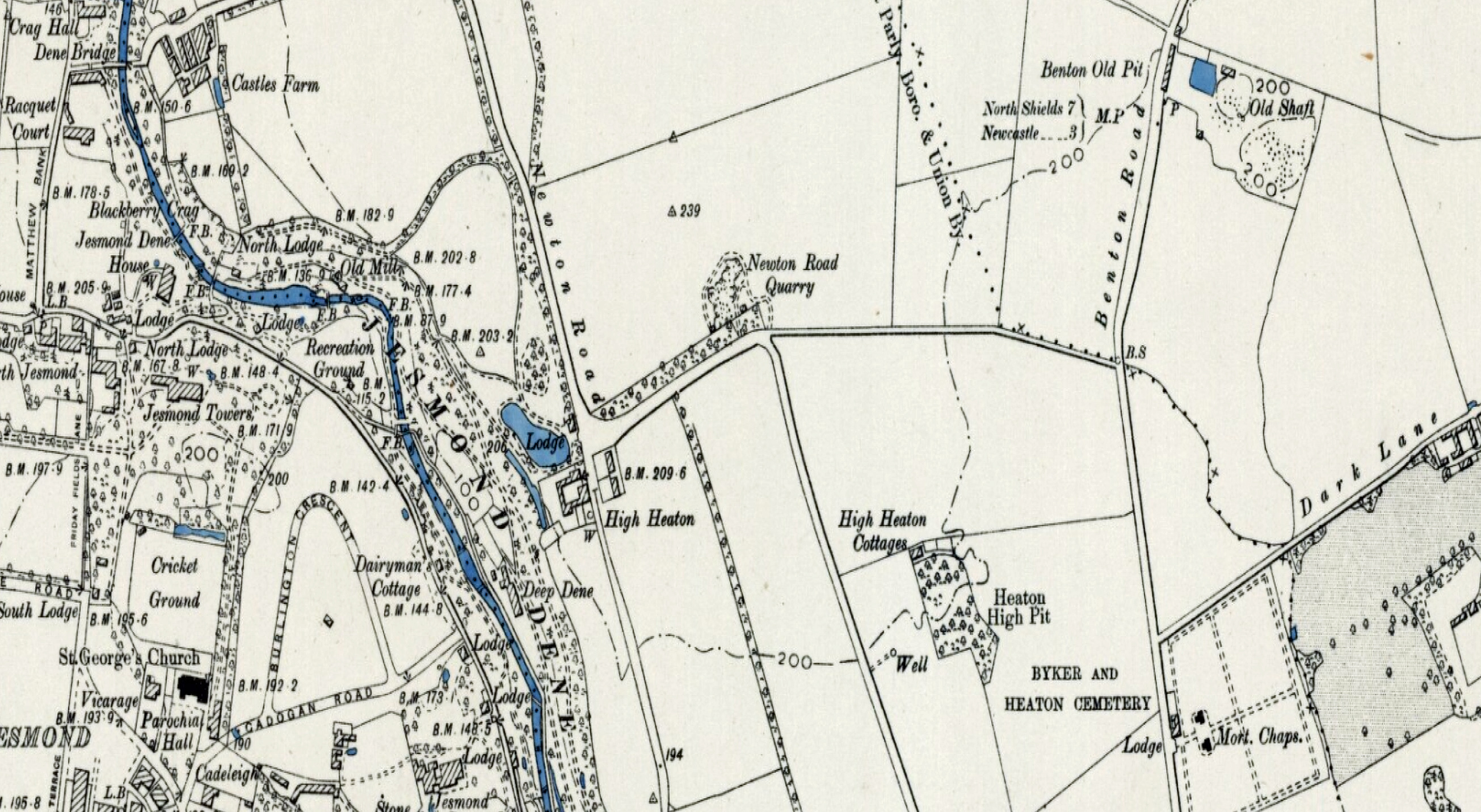Heaton High Pit (also known as the Far Pit or E Pit) was part of Heaton Main Colliery and was in High Heaton, opposite where Heaton Manor School is now. The mine lay just to the east of the Thistle Fault where the valuable, thick seam of coal known as the ‘Main Seam’ lay much further underground than in neighbouring areas to the west. Consequently, it was only towards the end of the 18th century that engineers had developed the technology to mine there.
Heaton Main
Heaton Main Colliery was technically one of the most advanced collieries in the world, attracting visitors from elsewhere in Britain and further afield, even America. Huge steam pumping engines drained the mine and a steam locomotive hauled coal along the colliery railway to the River Tyne. This was before George Stephenson built his locomotives for Killingworth Colliery.
We now remember Heaton Main Colliery for the 1815 disaster, in which 75 men and boys died. This took place about a mile from Heaton High Pit, approximately below the site of Saint Teresa’s Church. But there were problems at Heaton High pit too; a fire in 1810; and in 1813 ‘creep’, which caused the colliery floors to lift, meaning the pit was abandoned until 1816, one of the things that proves that this was not the site of the 1815 disaster.
What is particularly interesting about High Pit is that, unlike Heaton’s other pits, a small mining community, what we might call a ‘hamlet’, grew up around it. We’ve been researching the ten-yearly census records and newspaper reports relating to this community.

The above photograph of cottages at Heaton High Pit was taken in 1922 just before the present High Heaton estate was developed around the wooded area immediately above the old pit head, which we now know as The Spinney. It gives an idea of what the hamlet might have looked like.
Mining village
In 1841, there were around 25 households. Almost all the men were coal miners and, although 70 year old William Fenwick was a horse-keeper and 15 year old John Hall an apprentice smith, they too would have worked at the pit. Theirs were important jobs in the mining industry.
The surrounding area was rural: 35 year old John Twizell and 30 year old Alexander Cairns earned their living as agricultural labourers. Only two young women are listed as having a job: 15 year old, Margery Anderson and Elizabeth were servants.
In 1851, a few of the families remained from ten years earlier but many were recent migrants from other mining communities around Newcastle and the immediate area. Most men were still colliers but 18 year old Septimus Widderington was an engineer, 26 year old William Gascoigne a gardener and 40 year old William Taylor an agricultural labourer. Several women and girls are recorded as working: Elizabeth Clarke (18) as a dressmaker and Ann Ayre (14), Sarah Bell (21) and Jane Stephenson (38) as household servants.
Whereas boys as young as seven were among those killed in the 1815 disaster, the Mines Act of 1842 had made it illegal to employ anyone under ten underground, so the youngest miner in 1851 was ten year old James Cross. Nevertheless, siblings Anne, Mary and Christopher Roaby, aged four, five and seven, were the only children, among the many who lived in the hamlet, recorded as going to school .
Heaton High Pit was closed in 1852, the battle with floodwater having finally been lost, but many men of the village continued to work at nearby Benton Colliery. This was situated on what is now Wych Elm Crescent by the tram track across Benton Road from the Newton Park pub. You can see how close they were and how rural the area was on the OS map below.

In 1861, the village was still a mining community but some of the residents had come from further afield: for example, John Bowes, a cordwainer, had been born in Yorkshire; and Elizabeth Nichol in Cumberland. The recent birth and expansion of railways was a possible factor.
A school is listed in the census and 12 boys and girls, aged between 4 and 12 are recorded as attending. The youngest collier was 15 year old John Burdis. Ann Bell, a 50 year old married woman, recorded as the head of household, was a shopkeeper and her daughter, 24 year old Hannah Ramsay, earned her living as a dressmaker. By this time though, there were also a number of uninhabited dwellings, a sign perhaps that that the housing was now considered substandard and, with the local pit closed, the village had become a less attractive place to live.
In January 1862 miners, George Handy and Robert Minto, both of Heaton High Pit village, were killed in an accident at Benton Colliery.
In April 1864, the auction of the materials of 21 cottages at Heaton High Pit was announced in the local press, although the 1894 Ordnance Survey map below shows a couple of cottages just to the north of the present Spinney. By this time, trees had been planted as was customary over disused pitheads. You can also see that, although Jesmond to the west was beginning to be developed, as was Heaton to the south, High Heaton was still very rural, the sight of Byker and Heaton Cemetery being the most obvious change from 36 years earlier.

And just before WW1, when the map below was published, not that much seemed to have altered. But after the war, things moved quickly and by the late 1920s, many of the houses we are now familiar with had been built and the Heaton Secondary Schools had opened. But more of them another time!

Can you help?
If you know more about anyone who may have lived or worked at Heaton High Pit, we’d love to hear from you. You can contact us either through this website by clicking on the link immediately below the article title or by emailing chris.jackson@heatonhistorygroup.org
Acknowledgements
This article was researched and written by Chris Jackson with Les Turnbull and Michael Proctor as part of Heaton History Group’s HLF-funded ‘Heaton Beneath Our Streets’ project.

Another great piece of local history; again, well done Y’all, and thank-you.
Thank you, Keith!
Thank you very interesting and informative..